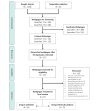Clinical Validity, Understandability, and Actionability of Online Cardiovascular Disease Risk Calculators: Systematic Review
- PMID: 29391344
- PMCID: PMC5814602
- DOI: 10.2196/jmir.8538
Clinical Validity, Understandability, and Actionability of Online Cardiovascular Disease Risk Calculators: Systematic Review
Abstract
Background: Online health information is particularly important for cardiovascular disease (CVD) prevention, where lifestyle changes are recommended until risk becomes high enough to warrant pharmacological intervention. Online information is abundant, but the quality is often poor and many people do not have adequate health literacy to access, understand, and use it effectively.
Objective: This project aimed to review and evaluate the suitability of online CVD risk calculators for use by low health literate consumers in terms of clinical validity, understandability, and actionability.
Methods: This systematic review of public websites from August to November 2016 used evaluation of clinical validity based on a high-risk patient profile and assessment of understandability and actionability using Patient Education Material Evaluation Tool for Print Materials.
Results: A total of 67 unique webpages and 73 unique CVD risk calculators were identified. The same high-risk patient profile produced widely variable CVD risk estimates, ranging from as little as 3% to as high as a 43% risk of a CVD event over the next 10 years. One-quarter (25%) of risk calculators did not specify what model these estimates were based on. The most common clinical model was Framingham (44%), and most calculators (77%) provided a 10-year CVD risk estimate. The calculators scored moderately on understandability (mean score 64%) and poorly on actionability (mean score 19%). The absolute percentage risk was stated in most (but not all) calculators (79%), and only 18% included graphical formats consistent with recommended risk communication guidelines.
Conclusions: There is a plethora of online CVD risk calculators available, but they are not readily understandable and their actionability is poor. Entering the same clinical information produces widely varying results with little explanation. Developers need to address actionability as well as clinical validity and understandability to improve usefulness to consumers with low health literacy.
Keywords: cardiovascular disease; risk assessment; risk communication; risk formats.
©Carissa Bonner, Michael Anthony Fajardo, Samuel Hui, Renee Stubbs, Lyndal Trevena. Originally published in the Journal of Medical Internet Research (http://www.jmir.org), 01.02.2018.
Conflict of interest statement
Conflicts of Interest: None declared.
Figures



Comment in
-
Comment on: Clinical Validity, Understandability, and Actionability of Online Cardiovascular Disease Risk Calculators: Systematic Review.J Med Internet Res. 2018 Mar 5;20(3):e10093. doi: 10.2196/10093. J Med Internet Res. 2018. PMID: 29506971 Free PMC article. No abstract available.
Similar articles
-
Favourable understandability, but poor actionability: An evaluation of online type 2 diabetes risk calculators.Patient Educ Couns. 2019 Mar;102(3):467-473. doi: 10.1016/j.pec.2018.10.014. Epub 2018 Oct 24. Patient Educ Couns. 2019. PMID: 30389187 Review.
-
Online decision aids for primary cardiovascular disease prevention: systematic search, evaluation of quality and suitability for low health literacy patients.BMJ Open. 2019 Mar 13;9(3):e025173. doi: 10.1136/bmjopen-2018-025173. BMJ Open. 2019. PMID: 30872547 Free PMC article.
-
Health Literacy in Clubfoot: A Quantitative Assessment of the Readability, Understandability and Actionability of Online Patient Education Material.Iowa Orthop J. 2021;41(1):61-67. Iowa Orthop J. 2021. PMID: 34552405 Free PMC article.
-
Total Knee Arthroplasty: A Quantitative Assessment of Online Patient Education Resources.Iowa Orthop J. 2022;42(2):98-106. Iowa Orthop J. 2022. PMID: 36601227 Free PMC article.
-
Comment on: Clinical Validity, Understandability, and Actionability of Online Cardiovascular Disease Risk Calculators: Systematic Review.J Med Internet Res. 2018 Mar 5;20(3):e10093. doi: 10.2196/10093. J Med Internet Res. 2018. PMID: 29506971 Free PMC article. No abstract available.
Cited by
-
The Impact of Health Literacy-Sensitive Design and Heart Age in a Cardiovascular Disease Prevention Decision Aid: Randomized Controlled Trial and End-User Testing.JMIR Cardio. 2022 Apr 15;6(1):e34142. doi: 10.2196/34142. JMIR Cardio. 2022. PMID: 35436208 Free PMC article.
-
Comparing a Digital Health Check With Traditional Nurse-Led Health Examinations Among Long-Term Unemployed Individuals: Comparison Study.J Med Internet Res. 2024 Oct 16;26:e49802. doi: 10.2196/49802. J Med Internet Res. 2024. PMID: 39412874 Free PMC article.
-
STAR Duodecim eHealth Tool to Recognize Chronic Disease Risk Factors and Change Unhealthy Lifestyle Choices Among the Long-Term Unemployed: Protocol for a Mixed Methods Validation Study.JMIR Res Protoc. 2021 Jun 1;10(6):e27668. doi: 10.2196/27668. JMIR Res Protoc. 2021. PMID: 34061041 Free PMC article.
-
Selfie-Related Incidents: Narrative Review and Media Content Analysis.J Med Internet Res. 2023 Sep 27;25:e47202. doi: 10.2196/47202. J Med Internet Res. 2023. PMID: 37756044 Free PMC article. Review.
-
Effect of interdisciplinary obesity care on metabolic markers and body weight in people with type 2 diabetes in a rural setting: A randomised controlled trial.Clin Obes. 2025 Apr;15(2):e12715. doi: 10.1111/cob.12715. Epub 2024 Nov 7. Clin Obes. 2025. PMID: 39511718 Free PMC article. Clinical Trial.
References
-
- Nutbeam D. Health literacy as a public health goal: a challenge for contemporary health education and communication strategies into the 21st century. Health Promotion International. 2000;15(3):259–267. doi: 10.1093/heapro/15.3.259. - DOI
-
- Adams RJ, Appleton SL, Hill CL, Dodd M, Findlay C, Wilson DH. Risks associated with low functional health literacy in an Australian population. Med J Aust. 2009 Nov 16;191(10):530–534. - PubMed
-
- Adult literacy and life skills survey, summary results. Australia (reissue) Sydney: Australian Bureau of Statistics; 2006. [2017-07-24]. http://www.ausstats.abs.gov.au/ausstats/subscriber.nsf/0/B22A471C221C7BA... 6sNWpqeJn.
-
- Sørensen K, Pelikan JM, Röthlin F, Ganahl K, Slonska Z, Doyle G, Fullam J, Kondilis B, Agrafiotis D, Uiters E, Falcon M, Mensing M, Tchamov K, van den Broucke S, Brand H. Health literacy in Europe: comparative results of the European health literacy survey (HLS-EU) Eur J Public Health. 2015 Dec;25(6):1053–1058. doi: 10.1093/eurpub/ckv043. http://europepmc.org/abstract/MED/25843827 - DOI - PMC - PubMed
-
- Rootman I, Gordon-El-Bihbety D. A vision for a health literate Canada: report of the Expert Panel on Health Literacy. Ontario: Canadian Public Health Association; [2017-07-31]. https://www.cpha.ca/vision-health-literate-canada-report-expert-panel-he... 6sNWwPUei.
Publication types
MeSH terms
LinkOut - more resources
Full Text Sources
Other Literature Sources

